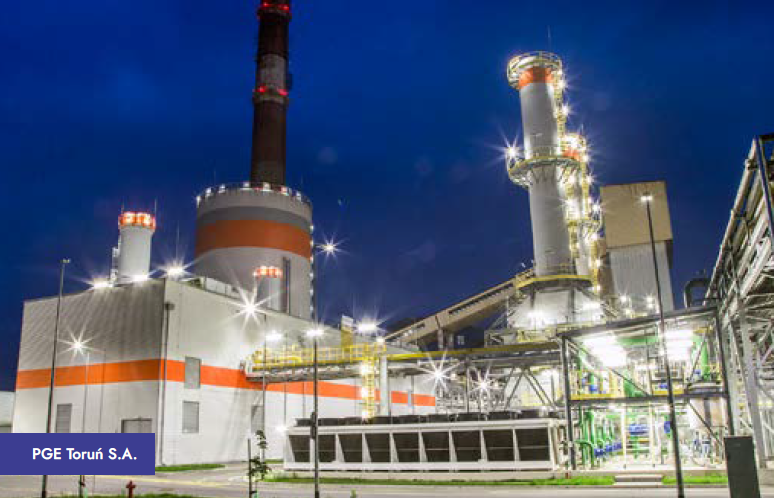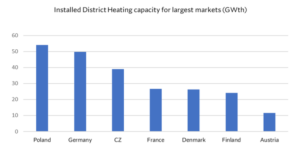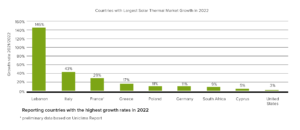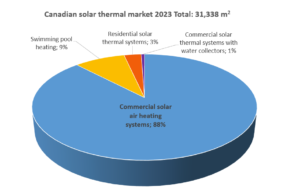

The EUR 100 billion challenge – transforming the Polish district heating sector
Poland’s energy supply is primarily fuelled by its own coal, making the air in some of the country’s cities some of the most polluted in Europe. As a member of the European Union, Poland is required to completely decarbonize its economy by 2050 by using renewable energy sources for electricity and heat. In its plan “Poland’s Energy Policy until 2040”, the former Polish government decided in February 2023 to increase the share of electricity from renewable energy sources to at least 32 % by 2030 and that of renewable heat to 28 %. But there is still no financial incentive in place for transforming the Polish district heating sector. Photo taken from PTEZ Report May 2023.
Having the largest district heat capacity in operation in the EU, Poland is well-equipped in terms of infrastructure to create an effective, economical and ecological heat supply. According to the Polish Association of Combined Heat and Power Plants (PTEZ), around half of all buildings are connected to district heating but around 75 % of it is still coal-fired. PTEZ estimates the costs for its transformation in line with the requirements of the EU Fit for 55 package at up to EUR 100 billion.
Power plant and district heating network operators are already endeavouring to convert their plants to gas and renewable energies. The systems primarily used are power-to-heat technologies such as electric boilers and heat pumps fuelled by green electricity, and to a lesser extent renewable energy sources such as waste heat, biomass and geothermal energy, while the effective, economical and in no way inferior solar thermal is rarely used.

Source: EuroHeat & Power
Translations of EU documents use ‘solar panel’ for both PV and solar thermal
“For various reasons, the importance of solar thermal energy is not developing as dynamically as would be desirable,” said Janusz Starościk, President of the Association of Manufacturers and Importers of Heating Equipment (SPIUG). He cited errors in the translation of EU documents as a curious reason for this. “Although these documents clearly define solar heat and photovoltaics, the translator treated everything as a ´solar panel`, which is associated with PV. This caused misunderstandings amongst decision makers and affected their attitude towards future use of solar thermal energy for heating”, he explained. In addition, he sees “Poland’s geographical location and a lack of experienced developers and installers of solar thermal systems” hindering “the realization of potential projects”.
“The Polish government’s most recent programme to promote solar thermal energy expired more than five years ago”, said SPIUG president Starościk, regretting the lack of a nationwide programme to promote the use of solar collectors in their various applications. All this is “responsible for the fact that solar thermal energy in Poland is far below its potential as a method of heat generation”.

Reporting countries with the highest growth in new solar thermal capacity in 2022
* Preliminary data based on the Uniclima Report, Source: Solar Heat Worldwide 2023
Dynamic growth from a low level
Jędrzej Maśnicki, Director for International Affairs at the energy supplier Polska Grupa Energetyczna (PGE), noted “a promising growth dynamic starting from a low level. While just 0.13 % of Polish households used solar thermal energy to contribute to their heating needs in 2018, the figure was already three times higher in 2021 at 0.4 %”. For 2022, the IEA SHC even listed Poland as the fifth strongest growth market for solar thermal energy worldwide, with an 11 % growth rate compared to the previous year (see chart above). But according to Maśnicki “the government support for renewable energy sources tends to focus more on photovoltaics and heat pumps than on solar collectors”.
Through its subsidiary PGE Energia Ciepła, PGE claims to be Poland’s leading producer of electricity and heat from combined heat and power. The utility company is aiming to achieve climate neutrality by 2050. As a step towards achieving this goal, PGE has committed to phasing out the use of coal in its district heating supply by 2030. High-emission sources are to be replaced by alternative solutions such as gas-fired systems and power-to-heat boilers and heat pumps fuelled by renewable energies.
Most recently, PGE has also utilized solar thermal energy in two of its 16 power plants. Last October, the utility company commissioned a gas-fired combined heat and power plant in Zgierz, which is supplemented by a solar thermal system with a capacity of 100 kW. And before the end of this year two combined heat and power plants with a solar collector field should be connected to the grid in Wrocław-Zawidaw.
According to PTEZ, there are currently around a dozen district heating networks supported by solar thermal energy in Poland. Half of these are listed by the 2018 Solar District Heating Plant Database as having comparatively small solar collector areas, ranging from 1,100 m² in Bartoszyce to 7,300 m² in Lodz. Some solar heat also feeds the country’s largest district heating network in the capital Warsaw, which is operated by the Polish subsidiary of the French company Veolia. 151 m2 of flat plate collectors including an over ground storage with a volume of 800 m2 are already in operation since 2015, as the installation is mentioned in a paper from 2016.
However, Veolia, like PGE and their competitors Fortum Poland, appears to prefer energy sources such as photovoltaics, waste heat, geothermal energy and biomass to solar heat in its decarbonization investments. In response to a journalistic request, Fortum Poland stated succinctly: “solar thermal energy is not in our business portfolio”. This may come as a surprise as a market study carried out by the Polish-German Chamber of Industry and Commerce (AHK Poland) concluded that “the potential of geothermal energy and biomass is limited in Poland, meaning that manufacturers of SDH installations in conjunction with large-scale solar collectors (…) have good market opportunities”.
New government will hopefully remove obstacles
According to Starościk, SPIUG activities were making solar thermal energy “reappear in the government’s strategies and plans for the greening of heating, but without any visible effects in the form of actively supporting measures”. But when in contact with his organization “district heating network operators have signalled their interest in using solar thermal systems with seasonal heat storage in order to meet the future requirements of the Emissions Trading System and reduce heating costs with free solar heat”.
However “outdated regulations”, particularly with regard to the environment but also from a technical point of view “have hindered the possibilities of building such plants”. He now hopes “that the new government will take care of removing these obstacles as quickly as possible”.
So far, Starościk thinks the plants of various sizes in operation in Poland “have not yet been spectacular investments that could be cited as examples of best practice”. However, the interest observed from district heating operators gives him confidence “that the importance of solar thermal energy for heating, but also for the generation of process heat in industry, will soon begin to develop rapidly”.
Websites of organizations mentioned in this news article:
Polish Association of Combined Heat and Power Plants: https://ptez.pl/
Association of Manufacturers and Importers of Heating Equipment (SPIUG): https://spiug.pl
Solar District Heating Plant Database: https://www.solar-district-heating.eu/en/plant-database/
PGE Group: https://www.gkpge.pl
Fortum Poland: https://www.fortum.com/
Solar Heat Worldwide 2023: https://www.iea-shc.org/solar-heat-worldwide


